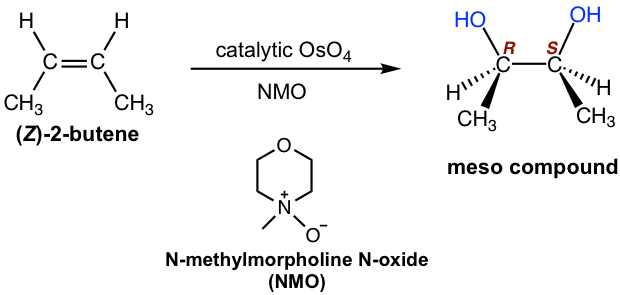10.7: Oxidation Reactions of Alkenes
- Page ID
- 359628
\( \newcommand{\vecs}[1]{\overset { \scriptstyle \rightharpoonup} {\mathbf{#1}} } \)
\( \newcommand{\vecd}[1]{\overset{-\!-\!\rightharpoonup}{\vphantom{a}\smash {#1}}} \)
\( \newcommand{\id}{\mathrm{id}}\) \( \newcommand{\Span}{\mathrm{span}}\)
( \newcommand{\kernel}{\mathrm{null}\,}\) \( \newcommand{\range}{\mathrm{range}\,}\)
\( \newcommand{\RealPart}{\mathrm{Re}}\) \( \newcommand{\ImaginaryPart}{\mathrm{Im}}\)
\( \newcommand{\Argument}{\mathrm{Arg}}\) \( \newcommand{\norm}[1]{\| #1 \|}\)
\( \newcommand{\inner}[2]{\langle #1, #2 \rangle}\)
\( \newcommand{\Span}{\mathrm{span}}\)
\( \newcommand{\id}{\mathrm{id}}\)
\( \newcommand{\Span}{\mathrm{span}}\)
\( \newcommand{\kernel}{\mathrm{null}\,}\)
\( \newcommand{\range}{\mathrm{range}\,}\)
\( \newcommand{\RealPart}{\mathrm{Re}}\)
\( \newcommand{\ImaginaryPart}{\mathrm{Im}}\)
\( \newcommand{\Argument}{\mathrm{Arg}}\)
\( \newcommand{\norm}[1]{\| #1 \|}\)
\( \newcommand{\inner}[2]{\langle #1, #2 \rangle}\)
\( \newcommand{\Span}{\mathrm{span}}\) \( \newcommand{\AA}{\unicode[.8,0]{x212B}}\)
\( \newcommand{\vectorA}[1]{\vec{#1}} % arrow\)
\( \newcommand{\vectorAt}[1]{\vec{\text{#1}}} % arrow\)
\( \newcommand{\vectorB}[1]{\overset { \scriptstyle \rightharpoonup} {\mathbf{#1}} } \)
\( \newcommand{\vectorC}[1]{\textbf{#1}} \)
\( \newcommand{\vectorD}[1]{\overrightarrow{#1}} \)
\( \newcommand{\vectorDt}[1]{\overrightarrow{\text{#1}}} \)
\( \newcommand{\vectE}[1]{\overset{-\!-\!\rightharpoonup}{\vphantom{a}\smash{\mathbf {#1}}}} \)
\( \newcommand{\vecs}[1]{\overset { \scriptstyle \rightharpoonup} {\mathbf{#1}} } \)
\( \newcommand{\vecd}[1]{\overset{-\!-\!\rightharpoonup}{\vphantom{a}\smash {#1}}} \)
\(\newcommand{\avec}{\mathbf a}\) \(\newcommand{\bvec}{\mathbf b}\) \(\newcommand{\cvec}{\mathbf c}\) \(\newcommand{\dvec}{\mathbf d}\) \(\newcommand{\dtil}{\widetilde{\mathbf d}}\) \(\newcommand{\evec}{\mathbf e}\) \(\newcommand{\fvec}{\mathbf f}\) \(\newcommand{\nvec}{\mathbf n}\) \(\newcommand{\pvec}{\mathbf p}\) \(\newcommand{\qvec}{\mathbf q}\) \(\newcommand{\svec}{\mathbf s}\) \(\newcommand{\tvec}{\mathbf t}\) \(\newcommand{\uvec}{\mathbf u}\) \(\newcommand{\vvec}{\mathbf v}\) \(\newcommand{\wvec}{\mathbf w}\) \(\newcommand{\xvec}{\mathbf x}\) \(\newcommand{\yvec}{\mathbf y}\) \(\newcommand{\zvec}{\mathbf z}\) \(\newcommand{\rvec}{\mathbf r}\) \(\newcommand{\mvec}{\mathbf m}\) \(\newcommand{\zerovec}{\mathbf 0}\) \(\newcommand{\onevec}{\mathbf 1}\) \(\newcommand{\real}{\mathbb R}\) \(\newcommand{\twovec}[2]{\left[\begin{array}{r}#1 \\ #2 \end{array}\right]}\) \(\newcommand{\ctwovec}[2]{\left[\begin{array}{c}#1 \\ #2 \end{array}\right]}\) \(\newcommand{\threevec}[3]{\left[\begin{array}{r}#1 \\ #2 \\ #3 \end{array}\right]}\) \(\newcommand{\cthreevec}[3]{\left[\begin{array}{c}#1 \\ #2 \\ #3 \end{array}\right]}\) \(\newcommand{\fourvec}[4]{\left[\begin{array}{r}#1 \\ #2 \\ #3 \\ #4 \end{array}\right]}\) \(\newcommand{\cfourvec}[4]{\left[\begin{array}{c}#1 \\ #2 \\ #3 \\ #4 \end{array}\right]}\) \(\newcommand{\fivevec}[5]{\left[\begin{array}{r}#1 \\ #2 \\ #3 \\ #4 \\ #5 \\ \end{array}\right]}\) \(\newcommand{\cfivevec}[5]{\left[\begin{array}{c}#1 \\ #2 \\ #3 \\ #4 \\ #5 \\ \end{array}\right]}\) \(\newcommand{\mattwo}[4]{\left[\begin{array}{rr}#1 \amp #2 \\ #3 \amp #4 \\ \end{array}\right]}\) \(\newcommand{\laspan}[1]{\text{Span}\{#1\}}\) \(\newcommand{\bcal}{\cal B}\) \(\newcommand{\ccal}{\cal C}\) \(\newcommand{\scal}{\cal S}\) \(\newcommand{\wcal}{\cal W}\) \(\newcommand{\ecal}{\cal E}\) \(\newcommand{\coords}[2]{\left\{#1\right\}_{#2}}\) \(\newcommand{\gray}[1]{\color{gray}{#1}}\) \(\newcommand{\lgray}[1]{\color{lightgray}{#1}}\) \(\newcommand{\rank}{\operatorname{rank}}\) \(\newcommand{\row}{\text{Row}}\) \(\newcommand{\col}{\text{Col}}\) \(\renewcommand{\row}{\text{Row}}\) \(\newcommand{\nul}{\text{Nul}}\) \(\newcommand{\var}{\text{Var}}\) \(\newcommand{\corr}{\text{corr}}\) \(\newcommand{\len}[1]{\left|#1\right|}\) \(\newcommand{\bbar}{\overline{\bvec}}\) \(\newcommand{\bhat}{\widehat{\bvec}}\) \(\newcommand{\bperp}{\bvec^\perp}\) \(\newcommand{\xhat}{\widehat{\xvec}}\) \(\newcommand{\vhat}{\widehat{\vvec}}\) \(\newcommand{\uhat}{\widehat{\uvec}}\) \(\newcommand{\what}{\widehat{\wvec}}\) \(\newcommand{\Sighat}{\widehat{\Sigma}}\) \(\newcommand{\lt}{<}\) \(\newcommand{\gt}{>}\) \(\newcommand{\amp}{&}\) \(\definecolor{fillinmathshade}{gray}{0.9}\)Alkenes undergo a number of reactions in which the C=C double bond is oxidized. For organic compounds, a conventional way to tell whether the oxidation or reduction occur is to check the number of C–O bonds or the C–H bonds. An oxidation reaction increase the number of C–O bonds or decrease the number of C–H bonds. On the other side a reduction reaction increase the number of C–H bonds or decrease the number of C–O bonds. The relative oxidation state of some common organic functional groups are listed here based on the trend.

1,2-Dihydroxylation, the conversion of the C=C double bond to 1,2-diol, is an oxidative addition reaction of alkene. Osmium tetroxide (OsO4) is a widely used oxidizing agent for such purpose. Potassium permanganate can be used as well, although further oxidation is prone to occur to cleave the diol because it is a stronger oxidizing agent (10.7.2).

The traditional method of 1,2-dihydroxylation with osmium tetroxide is a two-step procedure. Osmium tetroxide first reacts with alkene to from a cyclic osmate ester intermediate and this cyclic intermediate involves the syn addition of OsO4 to the double bond. The cleavage of the O—Os bond of the intermediate then take places in the second step with reducing agent NaHSO3, without modifying the stereochemistry of the C—O bond. The diol formed therefore has the syn stereochemistry property.


Catalytic OsO4 1,2-Dihydroxylation
The 1,2-dihydroxylation with osmium tetroxide an effective reaction that used very often in the labs for the preparing diol from alkene. However, this method has major drawbacks because osmium tetroxide is a highly toxic, volatile and expensive reagent. Improved methods have been developed that allow only catalytical amount of OsO4 being used in conjunction with a co-oxidant in stoichiometric amount. N-methylmorpholine N-oxide (NMO) is one of the most commonly employed co-oxidants. In such condition, osmium compounds are re-oxidized by NMO and can be reused to react with more alkenes, so only small molar percentage of OsO4 is necessary in the reaction mixture. The reaction proceeds smoothly with syn diols produced in good yield.

In terms of the stereochemistry of the product, although the syn addition could occur on either side of the alkene plane, that gives the same product which is the meso compound. This can be identified by either looking for the plane of symmetry of the product, or by assigning the absolute configuration on the chirality centers. Review the stereochemistry knowledge.
Examples

Solution:
The syn addition occurs on either side of the alkene plane, so both enantiomers are obtained with same amount as racemic mixture.

10.7.2 Oxidative Cleavage of Alkenes
Cleavage with Ozone
With stronger oxidizing agent being applied, the C=C double bond of alkenes can be oxidatively cleaved, and the alkene molecule is cleaved to smaller molecules.
The most effective way for cleaving alkene is to use ozone, O3, by a two-step process. Alkene is first reacted with ozone at very low temperature (-78 °C) and then treated with dimethyl sulfide, (CH3)2S, (or Zn/CH3COOH) to give the cleavage products. The whole process is called ozonolysis.

Ozonolysis results in the cleavage of the double bond, and each double bond carbon get bonded to an oxygen atom with a new double bond. The products of ozonolysis are aldehyde(s) and/or ketone(s), and the exact structures of the products depends on the structure of the initial alkene:
- Disubstituted alkene carbons are oxidatively cleaved to ketone;
- Monosubstituted alkene carbons are oxidatively cleaved to aldehyde;
- Unsubstituted alkene carbons are oxidatively cleaved to formaldehyde (HCHO).
Examples
Show ozonolysis products of following reactions:



Hint: To figure out the structure of ozonolysis product(s), “cut” the double bond, then “add” a “=O” (double bonded oxygen) to each carbon.



As shown with above examples, ozonolysis reaction is useful as a synthetic tool for certain aldehyde and ketone. Meanwhile, it is also a method for determining the position of double bonds in an alkene by working backward from the structure of the products.
Examples
Determine the structure of the alkene:

Approach: To determine the structure of initial alkene, we can work backwards by connecting two C=O bonds in the products together. The two C=O bonds are “connected” to give a C=C bond with all oxygen atoms “removed”. In this example, the two blue C=O bonds gives the blue C=C bond, and the two red C=O bonds gives the red C=C bond.

Mechanism for Ozonolysis
The hints mentioned earlier is to help us solving the problems with ozonolysis reaction, not the reaction mechanism. The mechanism of ozonolysis reaction is rather complicate that involves the formation of initial cyclic ozonide that decompose to fragments, and the fragment recombine to form a new cyclic ozonide, which is reduced to give products.

Cleavage with Potassium Permanganate KMnO4
Potassium permanganate, KMnO4, is another oxidizing agent that cleaves the C=C double bond of an alkene. Under hot basic condition, the oxidative cleavage products of alkenes could involve ketone, salt of carboxylic acid or carbon dioxide depends on the different substituent patterns on the alkene:
- Disubstituted alkene carbons are oxidatively cleaved to ketone;
- Monosubstituted alkene carbons are oxidatively cleaved to the carboxylic acid (in salt format);
- Unsubstituted alkene carbons are oxidatively cleaved to CO2 and H2O.

KMnO4 is a stronger oxidizing agent that further oxidize the initial cleavage products, therefore aldehyde is further oxidized to carboxylic acid (in salt format under basic condition). For terminal unsubstituted alkene carbons, the initial product is HCHO, which is then further oxidized to carboxylate CO32-in basic condition. Acidification of CO32-produces H2CO3 that decomposes to CO2 and H2O. Because of over oxidation, KMnO4 is not the useful reagent for the synthesis of aldehyde/ketone from alkenes.


